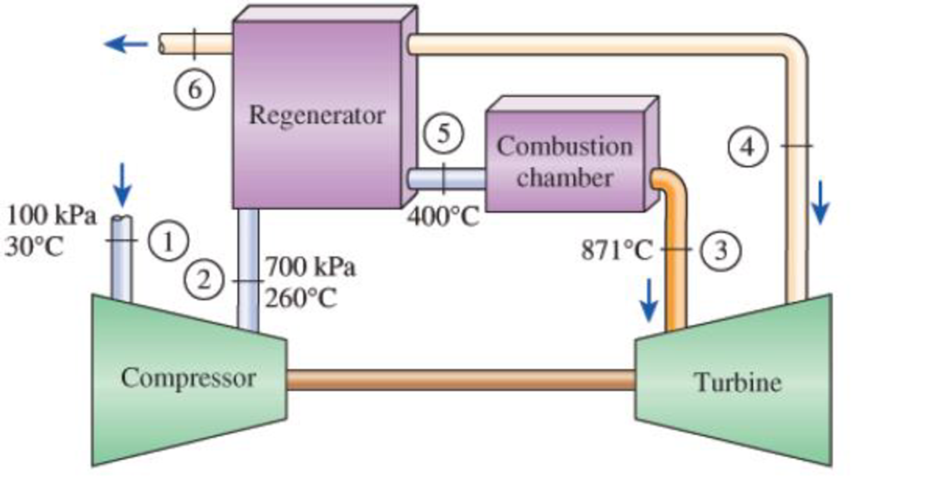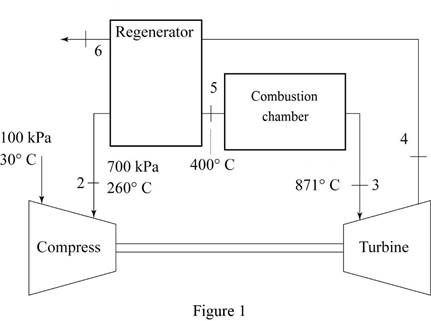
A gas-turbine power plant operates on the regenerative Brayton cycle between the pressure limits of 100 and 700 kPa. Air enters the compressor at 30°C at a rate of 12.6 kg/s and leaves at 260°C. It is then heated in a regenerator to 400°C by the hot combustion gases leaving the turbine. A diesel fuel with a heating value of 42,000 kJ/kg is burned in the combustion chamber with a combustion efficiency of 97 percent. The combustion gases leave the combustion chamber at 871°C and enter the turbine, whose isentropic efficiency is 85 percent. Treating combustion gases as air and using constant specific heats at 500°C, determine (a) the isentropic efficiency of the compressor, (b) the effectiveness of the regenerator, (c) the air–fuel ratio in the combustion chamber, (d) the net power output and the back work ratio, (e) the thermal efficiency, and (f) the second-law efficiency of the plant. Also determine (g) the second-law efficiencies of the compressor, the turbine, and the regenerator, and (h) the rate of the exergy flow with the combustion gases at the regenerator exit.

a)
The isentropic efficiency of the compressor.
Answer to Problem 152P
The isentropic efficiency of the compressor is
Explanation of Solution
Draw the layout of the gas-turbine plant functioning on the regenerative Brayton cycle as shown in Figure (1).

Consider, the pressure is
Write the expression to calculate the temperature and pressure relation ratio for the isentropic compression process 1-2s.
Here, the specific heat ratio is k.
Write the expression to calculate the isentropic efficiency of the compressor
Write the expression to calculate the temperature and pressure relation ratio for the expansion process 3-4s.
Write the expression for the isentropic efficiency of the turbine
Conclusion:
From Table A-2b, “Ideal-gas specific heats of various common gases”, obtain the following values of air at
Substitute 303 K for
Substitute 303 K for
Thus, the isentropic efficiency of the compressor is
Substitute 1144 K for
Substitute 1144 K for
b)
The effectiveness of the regenerator for regenerative Brayton cycle.
Answer to Problem 152P
The effectiveness of the regenerator for regenerative Brayton cycle is
Explanation of Solution
Write the expression to calculate the effectiveness of the regenerator
Conclusion:
Substitute 673 K for
Thus, the effectiveness of the regenerator for regenerative Brayton cycle is
c)
The air-fuel ratio in the combustion chamber.
Answer to Problem 152P
The air-fuel ratio in the combustion chamber is
Explanation of Solution
Write the expression for the heat input for the regenerative Brayton cycle
Here, the specific heat at constant pressure is
Write the expression to calculate the air-fuel ratio in the combustion chamber (AF).
Write the expression to calculate the total mass of the air-fuel mixture
Write the expression to calculate the heat input for the regenerative cycle
Conclusion:
Substitute
Substitute
Thus, the air-fuel ratio in the combustion chamber is
Substitute
Substitute
d)
The net power developed by the gas-turbine plant and the back work ratio for the gas-turbine plant.
Answer to Problem 152P
The net power developed by the gas-turbine plant is
The back work ratio for the gas-turbine plant is
Explanation of Solution
Write the expression to calculate the power given to the compressor
Write the expression to calculate the power developed by the turbine
Write the expression to calculate the net power developed by the gas-turbine plant
Write the expression to calculate the back work ratio for the gas-turbine plant
Conclusion:
Substitute
Substitute
Substitute 3168 kW for
Thus, the net power developed by the gas-turbine plant is
Substitute 3168 kW for
Thus, the back work ratio for the gas-turbine plant is
e)
The thermal efficiency of the gas-turbine plant.
Answer to Problem 152P
The thermal efficiency of the gas-turbine plant is
Explanation of Solution
Write the expression to calculate the thermal efficiency of the gas-turbine plant
Conclusion:
Substitute 2266 kW for
Thus, the thermal efficiency of the gas-turbine plant is
f)
The second-law efficiency of the gas-turbine plant.
Answer to Problem 152P
The second-law efficiency of the gas-turbine plant is
Explanation of Solution
Write the expression to calculate the second-law efficiency of the gas-turbine plant
Here, the maximum possible efficiency of the gas-turbine plant is
Write the expression to calculate the maximum possible efficiency of the gas-turbine plant.
Conclusion:
Substitute 303 K for
Substitute 0.735 for
Thus, the second-law efficiency of the gas-turbine plant is
g)
The exergy efficiency for compressor , turbine and regenerator.
Answer to Problem 152P
The exergy efficiency for the compressor is
The exergy efficiency for the turbine is
The exergy efficiency for the regenerator is
Explanation of Solution
Write the expression to calculate the stream exergy difference between the inlet and exit of the compressor
Here, the temperature of the surroundings is
Write the expression to calculate the exergy efficiency for the compressor
Write the expression to calculate the stream exergy difference between the inlet and exit of the turbine
Write the expression to calculate the exergy efficiency for the turbine
Applying energy balance for the regenerator process.
Write the expression to calculate the exergy increase of the cold fluid for the regenerator
Write the expression to calculate the exergy decrease of the cold fluid for the regenerator
Write the expression to calculate the exergy efficiency for the regenerator
Conclusion:
Substitute
Substitute
Thus, the exergy efficiency for the compressor is
Substitute
Substitute
Thus, the exergy efficiency for the turbine is
substitute
Substitute
Substitute
Substitute
Thus, the exergy efficiency for the regenerator is
h)
The rate of exergy of the combustion gases at the regenerator exit.
Answer to Problem 152P
The rate of exergy of the combustion gases at the regenerator exit is
Explanation of Solution
Write the expression to calculate the rate of exergy of the combustion gases at the regenerator exit
Conclusion:
Substitute
Thus, the rate of exergy of the combustion gases at the regenerator exit is
Want to see more full solutions like this?
Chapter 9 Solutions
Thermodynamics: An Engineering Approach ( 9th International Edition ) ISBN:9781260092684
- 12-217. The block B is sus- pended from a cable that is at- tached to the block at E, wraps around three pulleys, and is tied to the back of a truck. If the truck starts from rest when ID is zero, and moves forward with a constant acceleration of ap = 0.5 m/s², determine the speed of the block at D the instant x = 2 m. Neglect the size of the pulleys in the calcu- lation. When xƊ = 0, yc = 5 m, so that points C and D are at the Prob. 12-217 5 m yc =2M Xparrow_forwardsolve both and show matlab code auto controlsarrow_forward12-82. The roller coaster car trav- els down the helical path at con- stant speed such that the paramet- ric equations that define its posi- tion are x = c sin kt, y = c cos kt, z = h - bt, where c, h, and b are constants. Determine the mag- nitudes of its velocity and accelera- tion. Prob. 12-82 Narrow_forward
- Given: = refueling Powertran SOURCE EMISSIONS vehide eff eff gasoline 266g co₂/kwh- HEV 0.90 0.285 FLgrid 411ilg Co₂/kWh 41111gCo₂/kWh EV 0.85 0.80 Production 11x10% og CO₂ 13.7 x 10°g CO₂ A) Calculate the breakeven pont (in km driven) for a EV against on HEV in Florida of 0.1kWh/kM Use a drive cycle conversion 5) How efficient would the powertrain of the HEV in this example have to be to break even with an EV in Florida after 150,000 Miles of service (240,000) km Is it plausible to achieve the answer from pert b Consideans the HaXINERY theoretical efficiency of the Carnot cycle is 5020 and there are additional losses of the transMISSION :- 90% efficiency ? c A what do you conclude is the leading factor in why EVs are less emissive than ICE,arrow_forwardsolve autocontrolsarrow_forwardProblem 3.21P: Air at 100F(38C) db,65F(18C) wb, and sea-level pressure is humidified adiabatically with steam. The steam supplied contains 20 percent moisture(quality of 0.80) at 14.7psia(101.3kpa). The air is humidified to 60 percent relative humidity. Find the dry bulb temperature of the humidified air using (a)chart 1a or 1b and (b) the program PSYCH.arrow_forward
- A pump delivering 230 lps of water at 30C has a 300-mm diameter suction pipe and a 254-mm diameter discharge pipe as shown in the figure. The suction pipe is 3.5 m long and the discharge pipe is 23 m long, both pipe's materials are cast iron. The water is delivered 16m above the intake water level. Considering head losses in fittings, valves, and major head loss. a) Find the total dynamic head which the pump must supply. b)It the pump mechanical efficiency is 68%, and the motor efficiency is 90%, determine the power rating of the motor in hp.given that: summation of K gate valve = 0.25check valve=390 degree elbow= 0.75foot valve= 0.78arrow_forwardA pump delivering 230 lps of water at 30C has a 300-mm diameter suction pipe and a 254-mm diameter discharge pipe as shown in the figure. The suction pipe is 3.5 m long and the discharge pipe is 23 m long, both pipe's materials are cast iron. The water is delivered 16m above the intake water level. Considering head losses in fittings, valves, and major head loss. a) Find the total dynamic head which the pump must supply. b)It the pump mechanical efficiency is 68%, and the motor efficiency is 90%, determine the power rating of the motor in hp.arrow_forwardThe tensile 0.2 percent offset yield strength of AISI 1137 cold-drawn steel bars up to 1 inch in diameter from 2 mills and 25 heats is reported as follows: Sy 93 95 101 f 97 99 107 109 111 19 25 38 17 12 10 5 4 103 105 4 2 where Sy is the class midpoint in kpsi and fis the number in each class. Presuming the distribution is normal, determine the yield strength exceeded by 99.0% of the population. The yield strength exceeded by 99.0% of the population is kpsi.arrow_forward
 Elements Of ElectromagneticsMechanical EngineeringISBN:9780190698614Author:Sadiku, Matthew N. O.Publisher:Oxford University Press
Elements Of ElectromagneticsMechanical EngineeringISBN:9780190698614Author:Sadiku, Matthew N. O.Publisher:Oxford University Press Mechanics of Materials (10th Edition)Mechanical EngineeringISBN:9780134319650Author:Russell C. HibbelerPublisher:PEARSON
Mechanics of Materials (10th Edition)Mechanical EngineeringISBN:9780134319650Author:Russell C. HibbelerPublisher:PEARSON Thermodynamics: An Engineering ApproachMechanical EngineeringISBN:9781259822674Author:Yunus A. Cengel Dr., Michael A. BolesPublisher:McGraw-Hill Education
Thermodynamics: An Engineering ApproachMechanical EngineeringISBN:9781259822674Author:Yunus A. Cengel Dr., Michael A. BolesPublisher:McGraw-Hill Education Control Systems EngineeringMechanical EngineeringISBN:9781118170519Author:Norman S. NisePublisher:WILEY
Control Systems EngineeringMechanical EngineeringISBN:9781118170519Author:Norman S. NisePublisher:WILEY Mechanics of Materials (MindTap Course List)Mechanical EngineeringISBN:9781337093347Author:Barry J. Goodno, James M. GerePublisher:Cengage Learning
Mechanics of Materials (MindTap Course List)Mechanical EngineeringISBN:9781337093347Author:Barry J. Goodno, James M. GerePublisher:Cengage Learning Engineering Mechanics: StaticsMechanical EngineeringISBN:9781118807330Author:James L. Meriam, L. G. Kraige, J. N. BoltonPublisher:WILEY
Engineering Mechanics: StaticsMechanical EngineeringISBN:9781118807330Author:James L. Meriam, L. G. Kraige, J. N. BoltonPublisher:WILEY





